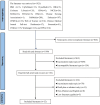Summary of best evidence for safe management of vasopressors through peripheral intravenous catheters
- PMID: 40745303
- PMCID: PMC12312446
- DOI: 10.1186/s12912-025-03635-3
Summary of best evidence for safe management of vasopressors through peripheral intravenous catheters
Abstract
Background: Vasopressors are critical for maintaining hemodynamic stability in critically ill patients, traditionally administered via central venous catheters (CVCs). However, CVCs carry risks of complications and insertion delays. Peripheral intravenous catheters (PIVCs) offer a rapid alternative but pose risks of extravasation and phlebitis. This study aimed to evaluate and summarize the evidence for the safe management of vasopressors through peripheral intravenous catheters, providing reference for clinical practice.
Methods: This evidence summary utilized the standard evidence summary report of Fudan University Center for Evidence-based Nursing, which includes problem establishment, evidence retrieval, literature screening, quality evaluation of the literature, the summary and grading of evidence. The registration number is "ES20246694". Current literatures were systematically searched for the best evidence for safe management of vasopressors through PIVCs. BMJ Best Practice, UpToDate, DynaMed, Joanna Briggs Institute, Cochrane Library, Guidelines International Network, National Institute for Health and Clinical Excellence, Scottish Intercollegiate Guidelines Network, Registered Nurses' Association of Ontario, Intravenous Nurses Society, Chinese Nursing Association, PubMed, Embase, CINHAL, Web of Science, Chinese Medical Journal Full-text Database, Sinomed, CNKI, Wanfang, and VIP were searched from database establishment to 27 June 2025. Literature types included clinical practice guidelines, clinical decisions, expert consensuses, systematic reviews, and evidence summaries.
Results: Our systematic search retrieved 1,925 publications, and finally identified 12 articles that had high-quality results. The evidence synthesis comprised three clinical decisions, four guidelines, one expert consensus, and four systematic reviews. We summarized the 29 pieces of best evidence from these articles, covering five aspects: training and education, infusion site selection, vascular access placement, infusion regimen optimization, and complication management. Of these pieces of evidence, 23 were 'strong' and 6 were 'weak', 9 pieces of evidence were recommended in level one.
Conclusion: The following 29 pieces of evidence for safe management of vasopressors through peripheral intravenous catheters were finally recommended. However, due to the multinational origin of the evidence, feasibility, appropriateness, clinical significance, and effectiveness must be evaluated within institutional contexts prior to implementation.
Keywords: Complications; Evidence-based nursing; Intravenous administration; Peripheral intravenous catheters; Vasopressors.
© 2025. The Author(s).
Conflict of interest statement
Declarations. Ethics approval and consent to participate: The study is a summary of best evidence of published material; therefore, ethics approval was not required. Consent for publication: Not applicable. Competing interests: The authors declare no competing interests.
Similar articles
-
Best evidence summary for prevention and management of enteral feeding intolerance in critically ill patients.J Clin Nurs. 2024 Mar;33(3):781-796. doi: 10.1111/jocn.16934. Epub 2023 Nov 22. J Clin Nurs. 2024. PMID: 37994227
-
Summary of the Best Evidence for Non-Pharmacological Management of Sleep Disturbances in Intensive Care Unit Patients.J Clin Nurs. 2025 Sep;34(9):3460-3472. doi: 10.1111/jocn.17622. Epub 2025 Jan 21. J Clin Nurs. 2025. PMID: 39834288 Review.
-
Evidence summary for the management of sleep disorders after malignant tumor surgery.Front Neurol. 2025 Jun 13;16:1580216. doi: 10.3389/fneur.2025.1580216. eCollection 2025. Front Neurol. 2025. PMID: 40584528 Free PMC article.
-
Health professionals' experience of teamwork education in acute hospital settings: a systematic review of qualitative literature.JBI Database System Rev Implement Rep. 2016 Apr;14(4):96-137. doi: 10.11124/JBISRIR-2016-1843. JBI Database System Rev Implement Rep. 2016. PMID: 27532314
-
A rapid and systematic review of the clinical effectiveness and cost-effectiveness of topotecan for ovarian cancer.Health Technol Assess. 2001;5(28):1-110. doi: 10.3310/hta5280. Health Technol Assess. 2001. PMID: 11701100
References
-
- Stampfl M, DeBlieux P. A clinical review of vasopressors in emergency medicine. J Emerg Med. 2024;67(1):e31–41. 10.1016/j.jemermed.2024.03.004. - PubMed
-
- Manaker S, Teja B. Use of vasopressors and inotropes. 2024; https://www.uptodate.com/contents/use-of-vasopressors-and-inotropes?sear....
-
- Evans L, Rhodes A, Alhazzani W, et al. Surviving Sepsis campaign: international guidelines for management of Sepsis and septic shock 2021. Crit Care Med. 2021;49(11):e1063–143. 10.1097/CCM.0000000000005337. - PubMed
Grants and funding
- ZHKYQ202415/Chinese Nursing Association Research Project
- KJZC-HL-202403/Nursing Research Project of Southeast University Zhongda Hospital
- 2024PYXM-A-04/Zhongda Hospital Southeast University Critical Care Medical Research "Cultivation Program" Project
- zdlyg27/Zhongda Hospital Affiliated toSoutheast University, Jiangsu Province High-Level Hospital Pairing Assistance Construction Funds
- zdlyg27/Zhongda Hospital Affiliated toSoutheast University, Jiangsu Province High-Level Hospital Pairing Assistance Construction Funds
LinkOut - more resources
Full Text Sources


